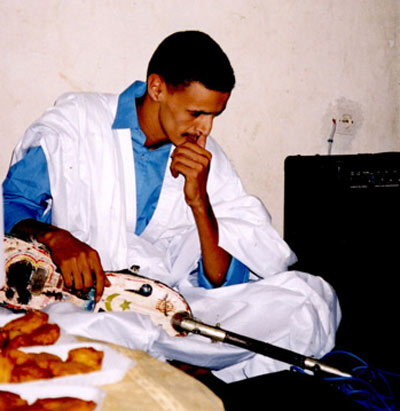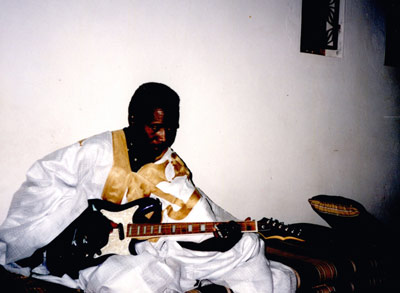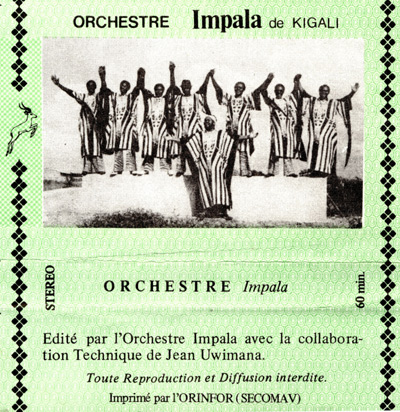Kadongo Kamu, or ‘one guitar music’, is a style of narrative song from central Uganda that dates back to the early 1950s. Over the last fifty years the genre has gone through many transformations, but has never strayed from its central purpose: communicating traditional wisdom and morals through anecdotes, stories, and social commentary. The earliest ‘Kadongo Kamu’ musicians accompanied their stories only with the Endongo (the bowl-lyre of the Baganda people), while later generations have turned to drum machines and electric guitars.
Although Kadongo Kamu has always attracted listeners in Kampala, it was, and as far as I can tell, remains, more popular in rural areas. When performing for appreciative audiences, Kadongo Kamu performers- especially in the past- would devote fifteen to twenty minutes to the telling of a particular epic; stretching and embellishing them as narrative twists caught the attention of their listeners. Some of the early pioneers of the genre were Christopher Sebadukka, Elly Wamala, and Fred Ssebatta. One of the few Kadongo Kamu performers to be noticed outside of Uganda was Bernard Kabanda, who passed away in 1999.
The 1970s were, for Kadongo Kamu performers, and most Ugandans, a difficult time. Idi Amin Dada’s repressive regime did not encourage political commentary by popular artists, and Kadongo Kamu musicians, for the most part, turned to singing love songs. But if the Kadongo Kamu recordings of the 1970s do not represent the genre’s poetic golden age, there are plenty of singles from the era that are very musically satisfying. We have quite a few of these 45s in our archive and I’ve picked out a few of my favorites. This is music for listening, not dancing, and the clear, repetitive guitar parts have a restrained charm.

In ‘Namusoke’, recorded in 1975, Chrizestom Ssebuziba announces: “I have a secret to reveal”, and goes on to tell the story of how he met the woman he loves.
- [audio:http://www.voanews.com/MediaAssets2/projects/african_music_treasures_blog/ssebuzibanamusoke.mp3] Chrizestom Ssebuziba ‘Namusoke’
The B-side of the single is ‘Ndowoza Suzanne’. Chrizestom tells the story of Suzanne: she abandoned him and now he wastes his time thinking about her, he doesn’t where she went or what to do with himself.
- [audio:http://www.voanews.com/MediaAssets2/projects/african_music_treasures_blog/chrizetomndowozasuzanne.mp3] Chrizestom Ssebuziba ‘Ndowoza Suzanne’

This single is my favorite of the bunch. In ‘Nakabiri’, Gerald Kaboggoza sings about one of his girlfriends. She is annoyed by his frugality. The moral of the story is ‘you should be generous to those you love’. It must not have worked out with the girlfriend in question.
- [audio:http://www.voanews.com/MediaAssets2/projects/african_music_treasures_blog/kaboggozanakabiri.mp3] Gerald Kaboggoza ‘Nakabiri’
The musicians accompanying Gerald Kaboggoza (Gerald may be one of the guitar players) remind me of Bern Nix, Charles Ellerbee, and Jamaladeen Tacuma when they were the heart of Ornette Coleman’s great 1970s Prime Time band. Every time I listen to ‘Anyize Lwa Butamuwa’ I hear parallels to the harmolodic interplay of Nix, Ellerbee, and Tacuma: pay attention to the guitars in the intro, and to the bass player-Jamaladeen could be playing those lines!! Interestingly, both this single and Ornette’s Prime Time masterpiece ‘Body Meta’ were released in 1975.
- [audio:http://www.voanews.com/MediaAssets2/projects/african_music_treasures_blog/kabagozaanyize.mp3] Gerald Kaboggoza ‘Anyize Lwa Butamuwa’

We have a handful of singles by Leo N. Ssekamanya. These next tracks are my favorite sides. He seems to drive his musicians a bit harder than Kaboggoza and Ssebuziba.
- [audio:http://www.voanews.com/MediaAssets2/projects/african_music_treasures_blog/ssekamanyazamufuula.mp3] Leo N. Ssekamanya ‘Zamufuula’
- [audio:http://www.voanews.com/MediaAssets2/projects/african_music_treasures_blog/sekumanyakabuladda.mp3] Leo. N. Sskemanya ‘Kabuladda’
Our final selection always gets a nice response from our more nostalgic radio listeners in Uganda. It is by the late great Eclas Kawalya. It is not, however, Kadongu Kamu music. This is an example of the dance-band music that was played in the clubs of Kampala in the 1960s.

Eclas Kawalya had a very long career and just passed away several years ago. His daughter Joanita inherited his musical gifts and has recorded many songs with the Afrigo Band. In ‘To Nyiiga’, which translates roughly as ‘don’t be annoyed’, Eclas tells the story of ‘Esther’ who, although they are not married, gave him a ring. Every time he looks at the ring he things of Esther. Eclas sings: ‘Esther, it is difficult for a man to shed tears.’
- [audio:http://www.voanews.com/MediaAssets2/projects/african_music_treasures_blog/kawalyatonyiiga.mp3] Eclas Kawalya ‘To Nyiiga’
Unfortunately, I have not been able to learn anything about the three Kadongo Kamu singers featured above, or about the Mukwano record label. Please, if you know anything about the record label or the singers , get in touch!!




















